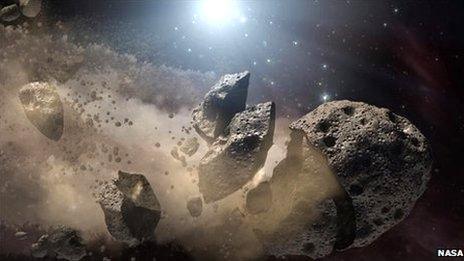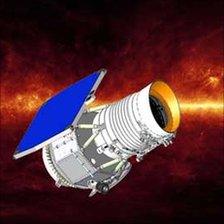Asteroid thought to kill dinosaurs may not be guilty
- Published

Collisions between asteroids in the main belt are common, creating families of fragments
New data from space have cast into doubt the identity of the asteroid that led to the extinction of the dinosaurs.
The current theory is that a large asteroid called Baptistina collided with another rock, throwing out huge fragments into the Solar System.
One of these fragments is believed to have struck Earth 65 million years ago, wiping out the dinosaurs.
But new data from the Nasa-run Wise telescope suggest that the Baptistina fragments are just far too young.
The candidate asteroid, Baptistina, is thought to have collided with another asteroid in the "main belt" between Mars and Jupiter, around 160 million years ago.
Huge fragments of rock, remnants of this collision, spread around the main asteroid belt, and a piece is thought to have been flung out towards Earth, causing a mass extinction of life when it impacted 65 million years ago.
Scientists initially identified Baptistina as the source of this fragment, using estimates of its age from information gathered from visible-light telescopes based on the ground.
Making estimations of size and age are difficult to do with only reflected sunlight however, and so researchers at Nasa have used infrared emissions from asteroids, measured by the Wide-Field Infrared Survey Explorer, to recalculate the sizes and ages of thousands of asteroids in the Solar System.
This new, more accurate information suggests that Baptistina didn't break apart until around 80 million years ago, giving it less time to make it to Earth.
Planetary swingball
The impact of a 10km-wide asteroid fragment left its mark in the huge Chicxulub crater in Mexico, and in a deposit of fine ash and rare elements in the geological record around the world 65 million years ago.
The impact coincided with the Cretaceous-Tertiary (K-T) extinction event that saw the loss of around 75% of all species on Earth, including the dinosaurs.

The Wide-Field Infrared Survey explorer scans the entire sky in 6 months.
Dr Amy Mainzer, principal investigator on the Neowise (Near-Earth Wise observations) project at the Jet Propulsion Lab (JPL) in California, said that "estimating the ages and origins of the asteroids should help us to correlate events on Earth and impact craters on the Moon with what is going on in the Solar System".
In the past, estimates of the age of asteroids have been made from the size of the object and how reflective it is; a more reflective asteroid is generally thought to be younger.
The size of an object in space has been traditionally measured by looking at how much sunlight is reflected from it.
But this method has many problems. Like the Moon, asteroids can wax and wane, depending on their position relative to the Sun. Dark coal-like rocks will also reflect less light than bright icy objects.
These problems can combine to make the size and age estimations inaccurate.
A Wise move
The Wise telescope instead looks at the infrared light emitted from space rocks, which is related to the temperature of the object.
Infrared light is emitted from all objects, even if they are dark, allowing a much more accurate calculation of their size and therefore their age.
Dr Mainzer explained: "We have collected data from 120,000 asteroids, and this is helping us to learn how the belt is made up."
Critically, the Baptistina family of asteroids - those that were formed when the larger asteroid destructively entered the main belt - were only formed around 80 million years ago.
This gives the dinosaur-killing rock only 15 million years to move into a suitable place to be flung out of the main belt and to travel to Earth in time for the impact 65 million years ago.
Scientists believe it would take an asteroid around 10 million years to travel from the main belt to Earth, so "this doesn't give a Baptistina fragment much time to get into a suitable position", said Dr Mainzer.
"The jury is still out, and we haven't completely ruled out Baptistina."
Following the relatively recent release of data from the Wise telescope in April this year, the teams at the Jet Propulsion Laboratory at Nasa have a "treasure trove" of information to work with.
Dr Mainzer expects that calculations, simulations and models based on this data "will keep people busy for decades".
- Published28 July 2011
- Published13 June 2011